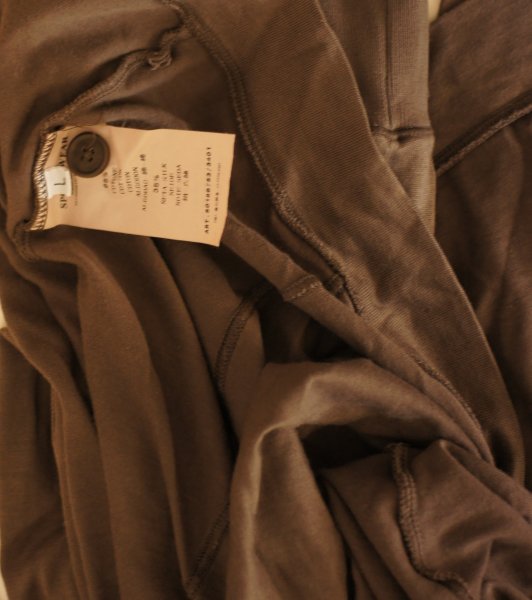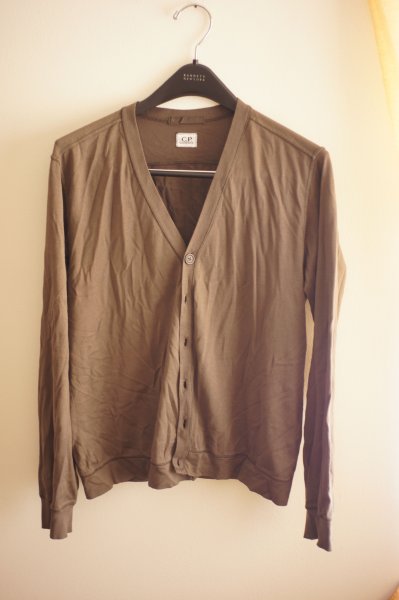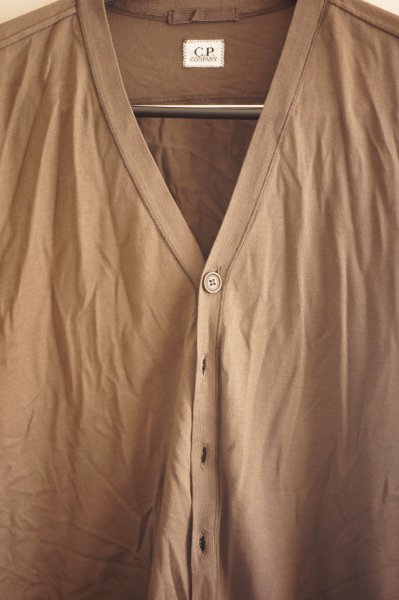the shah
OG Yamamoto
- Joined
- Jun 2, 2008
- Messages
- 17,566
- Reaction score
- 12,866
Worn sparingly. Size L but fits slim, good for 48. I've worn this maybe twice, far too slim to stay in my closet though it's been in there for a while.
Based in the Emilia-Romagna region of Italy, C.P. Company produces menswear fashions designed principally by Massimo Osti;
Company History: Introduced women's line, mid-1990s; U.S. subsidiary called C.P. Company Sportswear Inc.; purchased by the Rivettis and their Sportswear Company of Italy, 1993; Moreno Ferrari took over as designer from Osti, mid-1990s; closed New York flagship store, 1996; introduced fabrics containing metals such as copper and titanium, 1998; opened London flagship, 2000; launched Transformables, jackets that inflate into furniture, 2001.
Exhibition: Uniform: Order and Disorder, P.S.1/Museum of Modern Art, Pitti Immagine, 2001. Company Address: Via Confine 2161, 41017 Ravarino, Italy.
* * *
Based in the Emilia-Romagna region of Italy, C.P. Company produces menswear fashions designed principally by Massimo Osti;
Company History: Introduced women's line, mid-1990s; U.S. subsidiary called C.P. Company Sportswear Inc.; purchased by the Rivettis and their Sportswear Company of Italy, 1993; Moreno Ferrari took over as designer from Osti, mid-1990s; closed New York flagship store, 1996; introduced fabrics containing metals such as copper and titanium, 1998; opened London flagship, 2000; launched Transformables, jackets that inflate into furniture, 2001.
Exhibition: Uniform: Order and Disorder, P.S.1/Museum of Modern Art, Pitti Immagine, 2001. Company Address: Via Confine 2161, 41017 Ravarino, Italy.
Massimo Osti, long synonymous with C.P. Company, represented what C.P. Company stood for. He chose to live and work in his native Bologna, Italy, a university town populated by a young, international set. C.P. Company's headquarters is situated in the Emilia-Romagna region of Italy, renowned for its cuisine and local produce. As such, it—and Massimo Osti—were far removed from the hustle and bustle of Milan.
While Italian fashion designers have a propensity for generating myths around their collections, Osti's approach was in stark contrast to this prevailing trend. Osti conjured up no myths and was proud of it. He fashioned his collection not only from an aesthetic point of view but, first and foremost, from a functional one. Osti stuck close to his roots, and lived an understated lifestyle. Unlike some of his better-known counterparts, he was never in the limelight. He did not hold fashion shows, and his catalogues highlighted only clothes, with no glamorous models or exotic locations and no fancy studio lighting.
Osti was against artifice in any form; he did not consider himself to be a true designer, simply occupied with mastering the technical challenge of his line—specifically, the fabrics and finishes. He showed a new line twice a year but never referred to his output as a collection; rather, they were "pieces." There was never any uniting theme or story in the C.P. Company line.
The designer's working uniform consisted of a navy C.P. silk shirt and a pair of navy Stone Island jeans, with perhaps a navy tie. Osti loved to sail and even had a soccer field on his property. Hence, as a sportsman, he understood the need for performance sportswear. All his woven fabrics for C.P. Company were garment-washed, and he started using this process long before it was the rage in the men's sportswear industry. He was also one of the first to use water-repellent coatings on his fabrics, a process now standard on outerwear.
What would otherwise be a delicate item—such as a burlap linen raincoat—would be coated with polyurethane to make it practically indestructible. An indigo denim shirt would be garment-bleached and enzyme-washed to have the feel of silk. Such was the essence of Osti's philosophy, if he were willing to articulate one: to take fine, even luxury fabrics, and to treat them in such a way that they could be worn nonchalantly—or to take common fabrics and give them a luxury finish.
C.P. Company has been the essence of casual elegance and rugged versatility. It is stylish, never trendy, ideal for the man with good taste, a modicum of style, and a love of the finer things in life. Men who wear C.P. Company are averse to displaying designer labels, preferring instead to appear well dressed in an unself-conscious way. They also have an intellectual bent and are not impressed with flashy things. In other words, C.P. Company's customers were very much like Osti, who chose the Flatiron Building as the location for the company's New York store not only because of its architectural and historical significance, but because it was slightly off the beaten path, setting C.P. Company apart from the pack.
For over 20 years, Osti did for men's sportswear what perhaps Balenciaga did for women's couture. He honed it almost to a science, becoming the standard against which many other sportswear firms measured themselves. There is a strong probability that any novelty in finishing or dyeing one may encounter in the men's market has been tested—and probably developed—first by Osti. He was as thorough as they come in the area of fabric research, having at his disposal an archive of tens of thousands of items of used clothing, what he referred to as his "inspirational muse," and the "conscience" of the past. He deeply respected the styles of the past and strove to perfect them for the future. Although his fabrics were novel, his silhouettes were consistently classic, with an appealing lived-in quality.
For many years, the C.P. Company label carried the slogan "Ideas from Massimo Osti," and that in itself spoke volumes about the pragmatic approach of the line's designer. Yet C.P. Company underwent major changes in both ownership and design leadership at the end of the 20th century. Both the company and its sister brand, Stone Island, formerly owned by the Italian apparel powerhouse GFT, were purchased in 1993 by Carlo and Christina Rivetti, who operated the brands through their Sportswear Company of Italy. By the mid-1990s, founder Massimo Osti had moved on to other endeavors, and the designer Moreno Ferrari was established in his place. Despite these changes, the C.P. Company brand retained its focus on technical innovation, especially in the development of new materials, and fashion designs followed the dictates of the fabric.
In the mid-1990s, the company publicized its plans for a broad retail expansion, spearheaded by its Flatiron district store in New York. Over the years, it honed its expectations, opening flagship stores only in its two leading markets, the UK (London) and Italy (Milan), along with a smaller store in St. Tropez, France. The brands were also featured in freestanding stores in countries such as Japan and Korea. The New York outlet was shuttered in 1996. Although C.P. Company has periodically talked of opening another store in New York, it had not yet come to pass as of 2001.
The firm's retail spaces feature both C.P. Company and Stone Island branded sportswear items for men as well as C.P.'s women's sportswear range. As of 2000, the company sold through a total of 420 retail doors worldwide, including Bloomingdale's and Barneys New York according to the Daily News Record in January 2000.
Ferrari became Osti's focus, emphasizing durability and utilitarianism over fashion fads. In his fall-winter 1998/1999 collection, he reinvigorated some of the characteristics that had helped boost the brand's sales in the 1980s, notably a series of blousons designed for wary urban consumers. As DNR described the line in February 1998, it included one item (called "Metropolis") with an antismog mask, computer, mobile phone, and pockets for documents; another ("Life") with a noiseproof headset; and a third ("Munch") with a personal safety alarm. The last was inspired by Edouard Munch's famous painting, The Scream.
The year 1998 also brought the introduction of fabrics composed of copper, steel, carbon, and titanium initially intended to give a futuristic slant to the garments. The Italian journal Interni noted in June 2001 that these materials also provided performance advantages and a distinctive look and feel (light-reflective, movement-highlighting, crumpled-casual vintage) making them an integral part of the collection today.
For the 2001 season, C.P. Company's reputation for innovation moved to the foreground with its Transformables line, consisting of inflatable items that change nearly instantaneously from wearable objects into furniture. Packaged with an air compressor that could be plugged into a car's lighter, the line included jackets that become armchairs, mattress-tent combinations, sleeping bags, hammocks, and inflatable seats, representing the ultimate in convenient and minimalist travel gear.
—VickiVasipoulos
While Italian fashion designers have a propensity for generating myths around their collections, Osti's approach was in stark contrast to this prevailing trend. Osti conjured up no myths and was proud of it. He fashioned his collection not only from an aesthetic point of view but, first and foremost, from a functional one. Osti stuck close to his roots, and lived an understated lifestyle. Unlike some of his better-known counterparts, he was never in the limelight. He did not hold fashion shows, and his catalogues highlighted only clothes, with no glamorous models or exotic locations and no fancy studio lighting.
Osti was against artifice in any form; he did not consider himself to be a true designer, simply occupied with mastering the technical challenge of his line—specifically, the fabrics and finishes. He showed a new line twice a year but never referred to his output as a collection; rather, they were "pieces." There was never any uniting theme or story in the C.P. Company line.
The designer's working uniform consisted of a navy C.P. silk shirt and a pair of navy Stone Island jeans, with perhaps a navy tie. Osti loved to sail and even had a soccer field on his property. Hence, as a sportsman, he understood the need for performance sportswear. All his woven fabrics for C.P. Company were garment-washed, and he started using this process long before it was the rage in the men's sportswear industry. He was also one of the first to use water-repellent coatings on his fabrics, a process now standard on outerwear.
What would otherwise be a delicate item—such as a burlap linen raincoat—would be coated with polyurethane to make it practically indestructible. An indigo denim shirt would be garment-bleached and enzyme-washed to have the feel of silk. Such was the essence of Osti's philosophy, if he were willing to articulate one: to take fine, even luxury fabrics, and to treat them in such a way that they could be worn nonchalantly—or to take common fabrics and give them a luxury finish.
C.P. Company has been the essence of casual elegance and rugged versatility. It is stylish, never trendy, ideal for the man with good taste, a modicum of style, and a love of the finer things in life. Men who wear C.P. Company are averse to displaying designer labels, preferring instead to appear well dressed in an unself-conscious way. They also have an intellectual bent and are not impressed with flashy things. In other words, C.P. Company's customers were very much like Osti, who chose the Flatiron Building as the location for the company's New York store not only because of its architectural and historical significance, but because it was slightly off the beaten path, setting C.P. Company apart from the pack.
For over 20 years, Osti did for men's sportswear what perhaps Balenciaga did for women's couture. He honed it almost to a science, becoming the standard against which many other sportswear firms measured themselves. There is a strong probability that any novelty in finishing or dyeing one may encounter in the men's market has been tested—and probably developed—first by Osti. He was as thorough as they come in the area of fabric research, having at his disposal an archive of tens of thousands of items of used clothing, what he referred to as his "inspirational muse," and the "conscience" of the past. He deeply respected the styles of the past and strove to perfect them for the future. Although his fabrics were novel, his silhouettes were consistently classic, with an appealing lived-in quality.
For many years, the C.P. Company label carried the slogan "Ideas from Massimo Osti," and that in itself spoke volumes about the pragmatic approach of the line's designer. Yet C.P. Company underwent major changes in both ownership and design leadership at the end of the 20th century. Both the company and its sister brand, Stone Island, formerly owned by the Italian apparel powerhouse GFT, were purchased in 1993 by Carlo and Christina Rivetti, who operated the brands through their Sportswear Company of Italy. By the mid-1990s, founder Massimo Osti had moved on to other endeavors, and the designer Moreno Ferrari was established in his place. Despite these changes, the C.P. Company brand retained its focus on technical innovation, especially in the development of new materials, and fashion designs followed the dictates of the fabric.
In the mid-1990s, the company publicized its plans for a broad retail expansion, spearheaded by its Flatiron district store in New York. Over the years, it honed its expectations, opening flagship stores only in its two leading markets, the UK (London) and Italy (Milan), along with a smaller store in St. Tropez, France. The brands were also featured in freestanding stores in countries such as Japan and Korea. The New York outlet was shuttered in 1996. Although C.P. Company has periodically talked of opening another store in New York, it had not yet come to pass as of 2001.
The firm's retail spaces feature both C.P. Company and Stone Island branded sportswear items for men as well as C.P.'s women's sportswear range. As of 2000, the company sold through a total of 420 retail doors worldwide, including Bloomingdale's and Barneys New York according to the Daily News Record in January 2000.
Ferrari became Osti's focus, emphasizing durability and utilitarianism over fashion fads. In his fall-winter 1998/1999 collection, he reinvigorated some of the characteristics that had helped boost the brand's sales in the 1980s, notably a series of blousons designed for wary urban consumers. As DNR described the line in February 1998, it included one item (called "Metropolis") with an antismog mask, computer, mobile phone, and pockets for documents; another ("Life") with a noiseproof headset; and a third ("Munch") with a personal safety alarm. The last was inspired by Edouard Munch's famous painting, The Scream.
The year 1998 also brought the introduction of fabrics composed of copper, steel, carbon, and titanium initially intended to give a futuristic slant to the garments. The Italian journal Interni noted in June 2001 that these materials also provided performance advantages and a distinctive look and feel (light-reflective, movement-highlighting, crumpled-casual vintage) making them an integral part of the collection today.
For the 2001 season, C.P. Company's reputation for innovation moved to the foreground with its Transformables line, consisting of inflatable items that change nearly instantaneously from wearable objects into furniture. Packaged with an air compressor that could be plugged into a car's lighter, the line included jackets that become armchairs, mattress-tent combinations, sleeping bags, hammocks, and inflatable seats, representing the ultimate in convenient and minimalist travel gear.
—VickiVasipoulos




